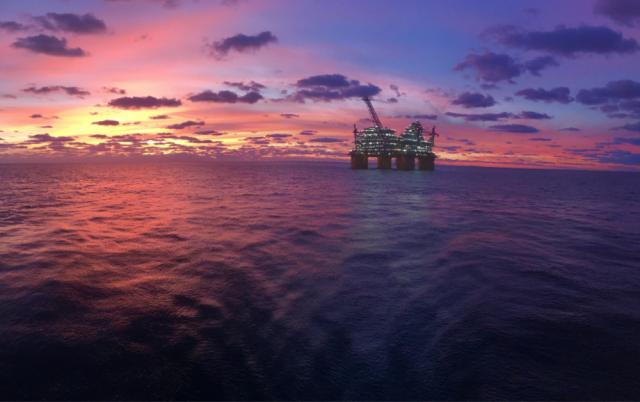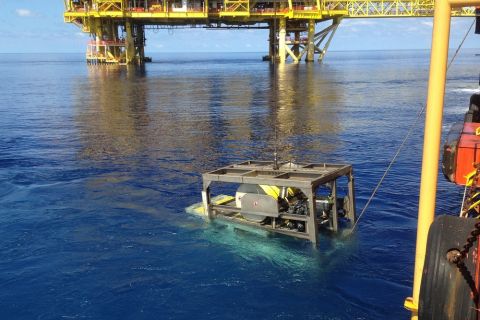
(Source: Shutterstock.com)
As offshore projects vie for capital in the low oil price environment, some say approaching technology the same way that drove the shale revolution could be a game changer for deep water.
Challenges facing the deepwater arena as well as technology opportunities surfaced during the latest OTC Live virtual session that brought together top-level executives from BP Plc, Chevron Corp., Dril-Quip Inc., Hess Corp. and Kosmos Energy Ltd. Panelists agreed that key technologies, standardization and use of existing infrastructure are critical for the success of the sector and keeping costs down.
Smart machinery, cloud-based solutions and digital analytics, and revolutionary corrosion preventative methods are among the technologies that came to mind for Richard Lynch, senior vice president of technology and services for Hess. Such areas could reduce capital costs and operating expenses, he said.
“Technology is going to be needed for a structural and step-change in our business in the deep water. So, we’re just beginning this journey in my mind,” Lynch said. “Technology drove the shale revolution if you think about the combination of fracture stimulation and long-reach directional wells. And if we have the same kind of thinking, that will unlock deep water.”
Starlee Sykes, senior vice president Gulf of Mexico and Canada for BP, added automation to remove people from offshore and improve safety; drones and inspection crawlers and advanced imaging to better understand the health of offshore facilities and longer subsea tiebacks to improve costs to the list. Finding ways to power offshore facilities more efficiently or with low-carbon power could be a gamechanger, she said, later adding seismic as another game-changing technology.
“I think it’s not only the technology around the image but also the processing technology and learning how we can do that using agile methods and other methods to decrease the cycle time and get an image quicker can let know whether or not we should continue to work on prospects is really helpful.”
The continued focus on technology and other ways to gain efficiency comes with less capital and pressure from investors to lower their carbon footprints.
Plus, there is also much to learn.
This includes use of more horizontal wells in deep water to improve well productivity and tertiary recovery around enhanced oil production using CO2. “We’ve got some concepts we’re thinking about where you can inject carbon into these giant deepwater reservoirs,” she said. “Think what that could do for helping the environment while also being more efficient in oil production.”
Ways to add to efficiency aren’t limited to the deepwater arena. There is something to learn from other asset classes as well, according to Mark Hatfield, vice president of Chevron Corp.
“We’ve all learned that sharing across asset classes has been a key to drive efficiencies,” Hatfield said. “When I look at the factory model used in the Permian Basin and what they’ve achieved with that demonstrated the benefits of standardization, and I think we had broad consensus that that is a huge game changer for both the unconventional and deepwater asset class.”
Standardization, Collaboration
Equipment standardization continues to be a focus offshore, particularly for service provider Dril-Quip.
Looking at the company’s subsea wellhead product line alone, Dril-Quip CEO Blake DeBerry said the company offers 14 versions of subsea wellheads globally. He believes the company can meet the industry’s needs with four.
Going forward, such product line management could lead to better inventory control and contain costs in DeBerry’s view. That’s not to say the company would not be willing to provide something different if requested. “But it comes at a price and probably with a longer lead time.”
Several oil and gas companies already see the benefits of standardization.
Many, like Chevron, have taken the “design one, build many” approach and partnering with peers on joint industry projects toward standardization of deepwater equipment. The goal is to drive down costs, according to Hatfield.
Faster drilling times and lower fixed daily costs have been key enablers for lower breakevens, he said. Attention has since shifted to improved efficiency with standardization—whether it’s of well design or equipment.
“In a lower price environment, that sense of urgency is very high. … To get there, we’re all going to have to work pretty closely together,” Hatfield said.
Simplification, standardization and collaboration are some of the common operational philosophies companies must have, according to Lynch, who recalled the reality of deep water becoming less attractive to some in the industry. However, sharing lessons learned from various well sites and activities can improve safety, lower costs and improve timing.
Infrastructure-led exploration and subsea tiebacks are among the trends that appear to be nonfading due to their timely and cost-effectiveness.
Existing Infrastructure
With few Gulf of Mexico facilities running at full nameplate capacity, “there’s a lot of opportunity for us to tie back to those facilities,” said Danny Hough, vice president of development for Kosmos Energy Gulf of Mexico.
Connecting a new oil or gas discovery to an existing production facility such as a new FPSO, spar or TLP could cut down on investment costs while also bringing down cycle times to a year to a year and a half compared to three to five years, he said.
“The economics start looking a whole lot better,” Hough said. “In this oil price environment, that may be the only thing we can do at this time.”
With flow lines that can be 20- and 30-miles long, flow assurance and efficient insulating systems are critical, he said, while speaking on technology.
Multiphase pump tiebacks, instead of single-phase pumps, could further improve economics.
Going forward, he added that multiphase pumps could also prove beneficial, further improving economics.
“You don’t need to bring in all of the tiebacks back to a facility. You can bring them to a subsea manifold,” Hough explained.
“And obviously, there’s a savings,” he added, noting one of the major benefits of multiphase pumping is the ability to pump multiple fields.
Staying Competitive
Deepwater remains a competitive resource with greater efficiencies unlocking material value, Hatfield said, pointing to the success of plays like the Lower Tertiary in the U.S. Gulf of Mexico where the Jack/St. Malo Field is located. Technology has helped open new opportunities offshore, allowing access to HP/HT reservoirs. But having more than one asset class in the portfolio is a plus, he added.
“Of course, that only works if we can prove that the cost to find, develop and operate sum up to make that investment competitive and worthwhile,” Hatfield said.
Lynch used the prolific Stabroek Block offshore Guyana, where Hess is a partner with Exxon Mobil Corp. and CNOOC Ltd., as an example of the attractiveness of some offshore projects.
“It’s really about the quality of the reservoir, the quality of the developments, that you have in your hand,” he said.
Liza Phase 1 has a breakeven of about $35/bbl, while Liza Phase 2 has a breakeven of around $25/bbl with Payara’s at about $32/bbl.
“When you can hit those kinds of numbers in the deep water, things are real and you can go forward with projects of that nature,” he said.
However, market conditions and lower budgets have slowed some projects. But many haven’t been scrapped altogether.
Kosmos, for example, delayed completion of its second Kodiak well to preserve capital and delayed some infrastructure-led exploration projects, Hough said.
“We’re taking this time to really high-grade our portfolio and complete the technical work that’s required to get these drill-ready prospects on the schedule,” he said.
Similar thoughts were shared by Chevron’s Hatfield.
“Nothing in Chevron’s deepwater portfolio has been canceled; however, due to market conditions Chevron has taken steps to preserve cash, support our balance sheet strength and preserve the long-term value,” Hatfield said. The company cut its 2020 capital exploratory budget by over 20%. “The good thing is the flexibility of our capital program allows us to respond to these pretty much unexpected market conditions by deferring shorter cycle investments and pacing projects not yet under construction.”
Focus on spending is not necessarily a negative.
“Capital has been constrained for a while and that’s actually a good thing,” said BP’s Sykes.
She recalled seeing excessive spending and waste in the industry during times of high oil prices and unconstrained capital.
“I’m optimistic that we’ve got some discipline in place now where we can focus on returning value to shareholders versus just producing more volume,” she said. “I think the constraint of capital in general, whether it’s oil price based or strategy, a company strategy or just discipline is a positive thing.”
Recommended Reading
2023-2025 Subsea Tieback Round-Up
2024-02-06 - Here's a look at subsea tieback projects across the globe. The first in a two-part series, this report highlights some of the subsea tiebacks scheduled to be online by 2025.
Forum Energy Signs MOU to Develop Electric ROV Thrusters
2024-03-13 - The electric thrusters for ROV systems will undergo extensive tests by Forum Energy Technologies and SAFEEN Survey & Subsea Services.
Betting on the Future: Chevron Technology Ventures’ Investment Strategy
2024-04-09 - After a quarter century, Chevron Technology Ventures seeks both incremental and breakthrough technologies with its early-stage investment program.
Lift-off: How AI is Boosting Field and Employee Productivity
2024-04-12 - From data extraction to well optimization, the oil and gas industry embraces AI.
TGS Commences Multiclient 3D Seismic Project Offshore Malaysia
2024-04-03 - TGS said the Ramform Sovereign survey vessel was dispatched to the Penyu Basin in March.






